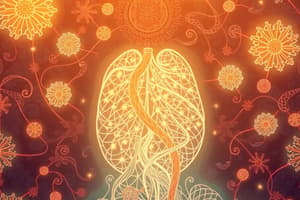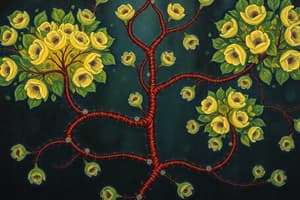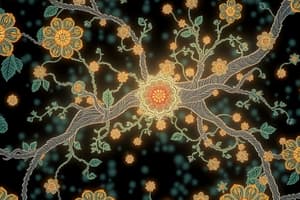Podcast
Questions and Answers
What is the main purpose of Acetyl CoA in the Krebs Cycle?
What is the main purpose of Acetyl CoA in the Krebs Cycle?
- It acts as an oxygen donor in the process.
- It enters a series of reactions to release energy. (correct)
- It is used to produce ATP directly.
- It initiates the breakdown of glucose into pyruvic acid.
Which component is formed when NAD+ combines with hydrogen ions and high-energy electrons?
Which component is formed when NAD+ combines with hydrogen ions and high-energy electrons?
- FADH2
- NADH (correct)
- Adenosine Triphosphate
- Carbon Dioxide
Which of the following is NOT a product of the Krebs Cycle?
Which of the following is NOT a product of the Krebs Cycle?
- Hydrogen Ions
- Glucose (correct)
- ATP
- Carbon Dioxide
In which part of the cell does the Krebs Cycle occur?
In which part of the cell does the Krebs Cycle occur?
What role do the hydrogen ions play in the Krebs Cycle?
What role do the hydrogen ions play in the Krebs Cycle?
Flashcards
Krebs Cycle
Krebs Cycle
A metabolic cycle occurring in the mitochondrial matrix that breaks down Acetyl CoA, releasing carbon dioxide, hydrogen ions, and electrons.
Acetyl CoA
Acetyl CoA
A 2-carbon molecule that enters the Krebs Cycle, formed from the breakdown of pyruvate.
NAD+
NAD+
An electron carrier that picks up electrons and protons during the Krebs Cycle, ultimately transporting them to the electron transport chain.
ATP
ATP
Signup and view all the flashcards
Electron Transport Chain
Electron Transport Chain
Signup and view all the flashcards
Study Notes
Stage 2: Krebs Cycle (Aerobic)
- Krebs cycle occurs in the mitochondrial matrix
- Requires oxygen (aerobic)
- Pyruvic acid, a molecule from glycolysis, enters the mitochondrion
- Each molecule of pyruvic acid is broken down to one molecule of carbon dioxide and a 2-carbon molecule called Acetyl CoA
- Acetyl CoA enters the Krebs cycle, a series of reactions
- In the reactions of the Krebs cycle, the molecule breaks down and releases carbon dioxide molecules, hydrogen ions (protons), and electrons
- Hydrogen ions and high-energy electrons combine with the electron acceptor NAD+ to form NADH
- NAD+ is short for nicotinamide adenine dinucleotide
Products of Krebs Cycle (Fate)
- ATP: releases energy, e.g. for active transport
- Carbon dioxide: released into the atmosphere. Used in photosynthesis by plants
- Hydrogen ions (H+) and electrons: Trapped by NAD+ to form NADH. This NADH is transported to the electron transport system.
Studying That Suits You
Use AI to generate personalized quizzes and flashcards to suit your learning preferences.




